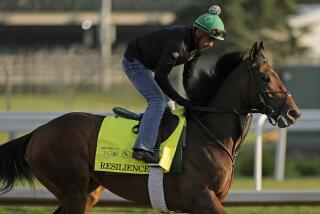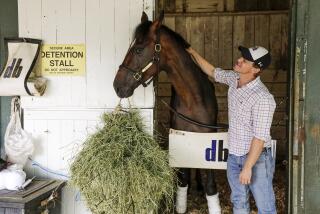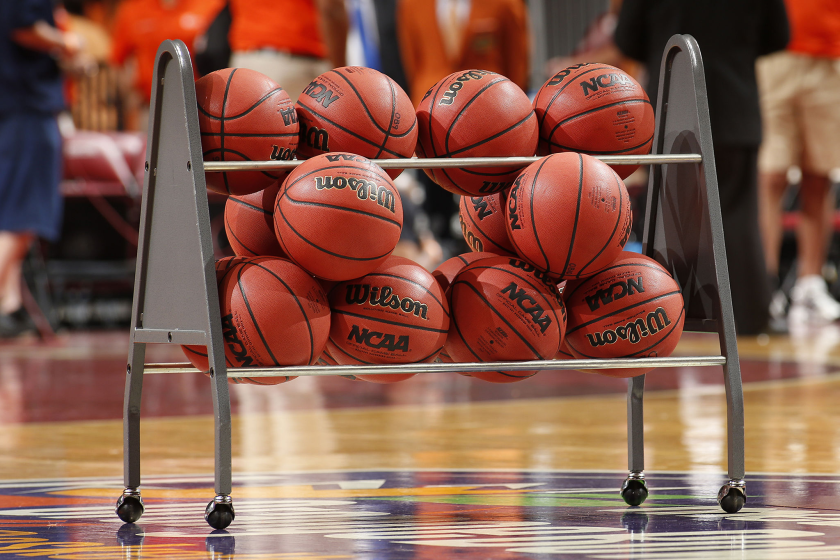Ankle Breaks, but Not Spirit : Spill Keeps Champion Grand Prix Rider Grounded
- Share via
A brass plaque proclaiming horse trainer Jimmy Williams’ credo-- No Guts, No Glory-- rests on the living room mantle in his home on the grounds of the Flintridge Riding Club.
Across the room, Susan Hutchison, 4th-place finisher in 1987 Pacific Coast rider-of-the-year standings and Williams’ open-jumping star pupil, reviews the videotape of her not-too-glorious spill recently in the L.A. Equestrian Center’s $50,000 Mercedes Grand Prix.
On tape, the accident only lasts 3 seconds. But it has kept her out of the arena for the last five weeks. She should be back in October.
“The horse got tangled up in the poles as she went to hit the ground,” said Hutchinson, 35, who fractured her right ankle when the horse, Flying Chicken, fell on her. “There was no way for her to avoid landing flat on me.”
But Hutchison is unswayed by the mishap and vows that it will not be cause for breaking stride in her career, which includes consecutive top-20 finishes in the American Grand Prix rider-of-the-year standings (1986-87), two straight Grand Prix wins at The Oaks in San Juan Capistrano (1987-88) and a first- and second-place finish this year in the Showpark Grand Prix at Rancho Santa Fe.
“What makes people afraid is lack of knowledge, and I pretty much have squared away why this happened,” she said. “It doesn’t effect my confidence at all.”
Like the sign says, No Guts, No Glory.
Williams says he plans to put Hutchison on a strict home rehabilitation regimen and admits that he may have to pull her reins in until she recovers adequately.
“I’ll have a hell of a time trying to keep her from riding for a while,” he said.
Coming back after injury is hardly terra incognita for Hutchison, who in 1971, her last year of junior competition, had an ankle-crushing fall at Coto de Caza in coastal Orange County.
“It drove me crazy the whole time,” said Hutchison, who didn’t ride for three months--a long time for a rider who had already won every junior medals final in California.
“At 18, that’s the end of the world,” she said.
But if youthful enthusiasm helped speed Hutchison’s comeback last time, her experience as a veteran will be the difference this time.
“The older you get and the more knowledge you get, the better you get,” she said.
These days, when she’s not riding, she spends her time imparting her wisdom to younger competitors who train at the stables.
“I love children,” she says. But she hastens to add, “it’s nice to say ‘hello’ to them in the morning and ‘goodby’ in the afternoon.”
Hutchison has learned to adjust her teaching style to the individual needs of her students, combining sensitivity with firmness.
“I’m not the type of student (who) can learn by being yelled at,” she said. “You have to decide who needs the yell and who needs to be taken aside, without being embarrassed in front of the group, and talked to. ‘What’s going on? How do you feel? Why don’t you feel comfortable?’ ”
This sensitivity was nurtured, she says, by an acquired rapport with horses.
“Each horse is a little bit different,” she said. “And every one has an individual personality. Horses are put in the ‘dumb animal’ category, but they’re only as smart as the person who trains them.”
If that’s true, Williams is well-represented by his stables as he is a 7-time winner of the annual California Thoroughbred Breeder’s Assn. award for the top thoroughbred in the show ring.
But don’t think Williams is manufacturing silk purses from sows’ ears--most of his championship horses cost him more than $100,000 and Fleetwood, whom Hutchison rode to a second-place finish at the Memorial Day Grand Prix, is worth more than $250,000.
“Because horses have become so expensive, people can’t afford to buy horses and donate them to the team,” Hutchison said. “It’s become who’s on top at the moment. Who has the best horses and what teamwork is working the best--I think that’s the better way.”
A few years ago, when she didn’t have a championship-quality horse to jump, Hutchison knew the feeling of being less than the best.
“It was frustrating to me, especially watching everyone else compete in the Grand Prix’s and knowing I didn’t have a horse to do it on,” she said.
But in July of 1985, Ann Kursinski, an East Coast rider who trained under Williams, sent Livius west because, according to Hutchison, “she didn’t think he had it in him anymore.”
With some back therapy and training from Williams, the horse has become one of Hutchison’s favorites.
“Once we got those things squared away, he’s been wonderful for me ever since,” she said. Williams says the success can be attributed to Hutchison more than the horses.
“She can maintain the rhythm of a horse and follow its motion,” he said. “She has the ability to steal a ride on a tough horse.”
But it’s Hutchison’s toughness that will allow her to shed the crutches and get back in the saddle again.
More to Read
Go beyond the scoreboard
Get the latest on L.A.'s teams in the daily Sports Report newsletter.
You may occasionally receive promotional content from the Los Angeles Times.











